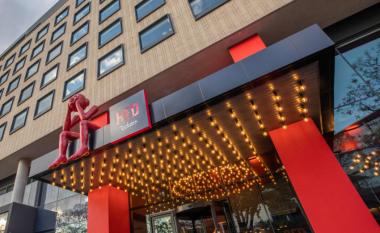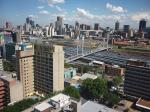Rosebank's Radisson Red Hotel achieves a 5-Star Green Star rating
 The Radisson Red hotel is conveniently situated at Oxford Parks in Rosebank.
The Radisson Red hotel is conveniently situated at Oxford Parks in Rosebank.
The Radisson Red Hotel at Oxford Parks has achieved a 5-Star Green Star Custom Hotel v1 certification, making it the fourth only project to be certified under this tool.
The eight-storey hotel building, developed by Intaprop, is situated within a walkable pedestrian network with easy access to bus stops and various amenities, including Rosebank Mall.
“It’s impossible to put a value on a building that brings integrity to its urban landscape,” says Carollyn Mitchell, Director at Intaprop.
“The City of Johannesburg has signed the C40 agreement, which is about doing the right thing for the city and its future generations. At Intaprop, we fully support this drive to make the right environmental choices. Oxford Parks is designed to take Green Star into the public realm, and we actively encourage our partners and tenants to lead the way in this respect”.
Martin Lardner Burke, Senior Associate at dhk, elaborates on the building’s architecture: “The design was a direct response to the clear definitive brand standards, site orientation and overall location within the precinct. These three components established the overall form, orientation, and look and feel of the building”.
“Double volume glazing was constrained to the long south façade and short east and west facades to limit heat loading on the glazing, and performance glass was specified as needed. We specified robust local materials where possible to reduce the overall carbon load of the building and minimise future maintenance requirements.”
Annelide Sherratt, Head of Department: Green Building Certifications at Solid Green, adds: “Innovation was an important part of the process. The Innovation credit that the project targeted was based on the WELL Exterior Active Design credit. This required the project to leverage site design and amenities within the immediate vicinity to encourage the building users to engage in physical activity throughout the day.”
The WELL credit promotes investment in urban infrastructure to support a vibrant community by stipulating walkable surrounds to the building, to prioritise pedestrian movement above motorised transport. The ground floor level is public and freely accessible, with walking paths throughout the site that are not impeded by fences or gates. The design also incorporates outdoor spaces that can be used year-round and that contain seating and biophilic elements. Various artistic installations have been placed strategically at the key access points to the site, at entrances to the building, and internally on public levels.
The hotel also supports occupant and visitor activity by facilitating the use of bicycles with 8 staff bike racks with lockers, 18 visitor bike racks and a staff shower.
A number of energy, water and environmental initiatives contributed to the certification. An energy model of the building was generated in the design stages of the project, which helped to inform decisions to achieve an energy consumption efficiency of over 60% improvement when compared to a SANS 10400 notional building. Further modelling enabled a high level of thermal comfort by ensuring that the internal operative temperatures are within the ASHRAE Standard 55-2004 Acceptability Limits for at least 98% of occupied hours.
A smart irrigation system uses soil moisture sensors that provide highly accurate readings of soil moisture under all conditions of temperature and soil chemistry. This, together with water efficient fittings that limit occupant water usage, allow water savings of approximately 43% against a notional building reference case.
To better understand and manage consumption and assess opportunities for energy savings, all major energy and water consuming systems are sub-metered.
A project-specific Environmental Management Plan established guidelines for the construction process to minimise the environmental impact associated with construction activities; and a project-specific Waste Management Plan helped to minimise the contribution of waste going to landfill. The project also aims to recycle or reuse 60% of the total waste from the hotel, and a waste recycling storage area with 30 bins has been provided to encourage building users to minimise waste going landfill sites.
In proactively engaging with the public realm and implementing forward-thinking sustainability initiatives, the Oxford Parks Red Radisson has made a significant contribution to the precinct’s overall vision of attaining a high quality, vibrant environment for its users.















